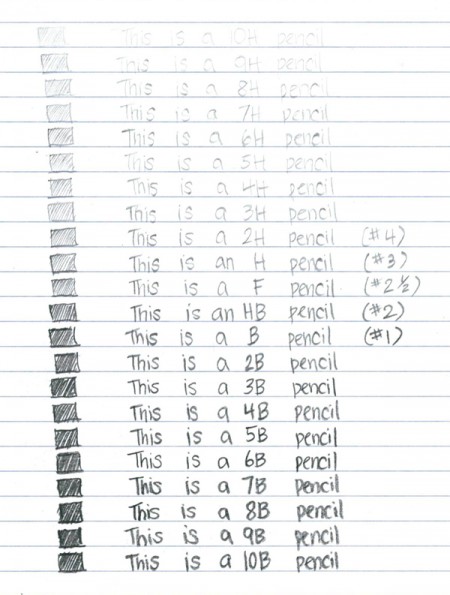I usually try to make sure I’ve done my research prior to posting a blog. As I was thinking about the post about the ceramic ring test, however, it occurred to me that there are a couple of variables that I had not previously considered – – the pencil and the means of applying the markings to the rings. So I decided to do a little research.
On researching pencils, I found that there is no unified specification for pencils. There are some guidelines the most common of which are the European Scale and the American scale. The following illustration shows how wide the range of pencil hardness can be.

In most cases, pencils are rated in “hardness (H)” and “blackness (B).” Individual manufacturers set their own standards and there is no reliable “conversion chart” – – note that the numbers have been “penciled in” in the above.
The “lead” in a pencil is not really lead (of course) but, in most common wood encased pencils, is a mixture of graphite and clay and in some cases “grease” in varying amounts. The mixture is then molded and fired to harden. In an internet search, I discovered that there are also other materials which may be added to the mixture to provide certain properties. Any additive would, it seems, alter the properties of the pencil marking as it is applied to ceramic making it easier or more difficult to remove. One that was specifically mentioned was wax. I’m pretty sure that wax would make the pencil marking more difficult to remove. Also, polymers are often used in the lead for mechanical pencils to add hardness and durability to limit breaking of the thin lead. I don’t know if a polymer would make the pencil marking easier or more difficult to remove.
The other variable(s) would be speed and pressure. I’m sure the ceramic ring test was first applied by simply scribbling on the ring by hand. I have, however, encountered a number of home-brew contraptions that been used to speed up the tedious process of scribbling. One I remember had a little platform on a spinning motor to hold the ceramic ring while the pencil was drawn over its face (a little like the track on a record.) In this case, the high speed may have caused heat which would also change the properties of the deposit on the ring. Varying pressure might also change the properties of the deposit left on the ceramic ring making it easier or more difficult to remove
In summary, despite the efforts to keep the surface of the ceramic rings consistent, keeping the process of depositing graphite on the ring may not be as controllable as one might think. In fact, there is little or no assurance that a #2 pencil supplied by the same manufacturer in two different (or even the same) lots will be the same. I don’t mean to debunk the entire test, but the above variations have not, as far as I know, been investigated. They may make a difference or they may not. The best advice at this point would be to try to keep things as consistent as possible. I know I have violated that rule many times as I pulled out my mechanical pencil with an HB lead to scribble on rings. Knowing what I know (or don’t know) now, I’ll try to be more careful in the future.
– FJF –

 Water – De-ionized – Hints
Water – De-ionized – Hints  A Fond Farewell to John Fuchs
A Fond Farewell to John Fuchs  Millipore Testing – Evaluation by Particle Counting
Millipore Testing – Evaluation by Particle Counting  Tape Test for Cleaning Revisited
Tape Test for Cleaning Revisited